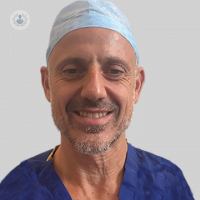Sacroiliac joint pain: what does it feel like?
Written in association with:There are two sacroiliac bones on the left and right of the lower part of your spine. These joints do not need to move like the other parts of your spine as they support and provide stability to the upper body weight.
Sacroiliac joint pain occurs when there has been damage or an injury to the joint between the spine and hip. It can cause lower back pain that is dull and aching and can be felt more mildly or severely in each individual case. The pain can spread to the hips, buttocks or groin.
Here, top neurosurgeon Mr Sinan Barazi explains more about sacroiliac joint pain, including the causes and how it is treated.

What causes sacroiliac joint dysfunction?
The sacroiliac joints are covered in a protective layer of cartilage and when this wears down, it can cause the bones to rub on each other. This usually occurs as a result of ageing and leads to degenerative arthritis.
Sacroiliac joint dysfunction may also be caused by pregnancy as the body is relaxing the muscles and joints in preparation for childbirth. Increased movement and changes of the joints will result in extra stress on the sacroiliac joints, which can cause pain.
Pain may also occur when there are changes in the ligaments, which means that if they become too loose or even too tight, the sacroiliac joints can become painful and inflamed. These are usually the result of a fall, an injury, surgery, ageing, altered walking patterns and other medical conditions.
What are the symptoms of sacroiliac joint pain?
The pain starts in the lower back and will radiate down to your hips, legs, buttocks and thighs. It is usually felt on one side and becomes worse during physical activities such as walking, climbing the stairs or standing for long periods of times.
The pain can feel sharp and a dull ache as well as a sensation of numbness or tingling.
How is it diagnosed?
During diagnosis, there will be a physical examination to test your reflexes, range of movement and pain levels. The doctor will apply pressure to your joints to find a pain source.
An MRI scan, CT or X-ray will be able to provide detailed images of the joints and surrounding bones, which will confirm the diagnosis.
If the imaging tests do not confirm the condition, an injection containing corticosteroid and a local anaesthetic will be placed into the sacroiliac joints to numb the area. If the pain continues afterwards, then it is unlikely that the joints are the source of pain.
How is sacroiliac joint pain treated?
The specialist will recommend non-surgical treatment such as physical therapy and stretching first. Anti-inflammatory medications such as ibuprofen, naproxen, creams, patches and salves may also help.
Steroid injections can target pain without the need for surgical intervention. The injections reduce swelling and inflammation but are only temporary and will need to be repeated. Nerve blocks are also useful in delivering an electrical current to stop the nerve fibres from sending pain signals to the brain.
Surgery is the last option, which involves a fusion of the sacroiliac joints. Titanium plates and screws are placed with the joints and fused together to promote bone growth. This stops all movements from the joints and stops the pain.
Do not hesitate to book an appointment with Mr Barazi if you would like to know more about a treatment plan for sacroiliac joint dysfunction.


